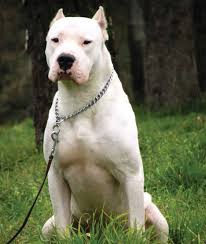Status dog facts for kids
A status dog is a term used in the United Kingdom for a dog that someone keeps to look tough, scare others, or even use as a weapon. This idea of using dogs to show power has been around for a very long time, even since Roman times. More recently, after some dogs attacked people, the UK passed the Dangerous Dogs Act 1991. This law put rules on owning and caring for four types of dogs: the Pit Bull Terrier, the Japanese Tosa, the Dogo Argentino, and the Fila Brasileiro. Two other breeds, the Rottweiler and the Staffordshire Bull Terrier, are also often seen as status dogs. To help with this issue, the Metropolitan Police in London even created a special Status Dog Unit in 2009.
Contents
History of Status Dogs
Dogs have been used for protection and even in fights for thousands of years. As far back as the 7th century BC, the Roman army used dogs in battles. Over time, certain dog breeds started to get a bad reputation because of how they were used.
In the 1800s, bloodhounds faced criticism in America because they were used to track down people who had escaped slavery. Later, the Doberman breed, which was once seen as noble and trustworthy, also got a bad name. This happened after photos from World War II showed Nazi officers with their Doberman dogs in concentration camps. Governments and media then started to show Dobermans, along with Rottweilers and German Shepherds, as "demon dogs."
The pit bull, one of the most well-known status dogs, has a history going back to the Middle Ages. This breed was created over many centuries through selective breeding. This means people carefully chose dogs with certain traits, like being strong or aggressive, to have puppies. Pit bulls were bred to be fierce for a sport called bull-baiting in the 1800s, where dogs fought bulls. When bull-baiting was banned, a new, illegal sport called dog fighting became popular.
This history led to the pit bull's tough public image. In the 1960s, street gangs started using pit bulls as symbols of strength. Their image got even worse in 1987 when a young boy in California was attacked and killed by a pit bull. Big magazines like Sports Illustrated and Time put pit bulls on their covers with headlines like "Beware of this dog." This led to new laws in the US that banned certain dog breeds. In 1991, a similar event happened in the UK, where a six-year-old girl was badly hurt by a pit bull in a park. This incident directly led to the Dangerous Dogs Act 1991 in the UK.
Types of Status Dogs
There are different ways to describe status dogs, especially in legal terms:
- "Weapon Dogs" are dogs used by their owners to scare people or cause harm. These dogs are usually not trained properly. Using a dog this way often breaks laws like the Dangerous Dogs Act 1991 and the Guard Dogs Act 1975, which have rules about how such dogs should be kept.
- "Dangerous Dogs" is a legal term for dogs that are "dangerously out of control." This means there's a good reason to believe the dog might hurt someone, even if it hasn't yet. This rule applies whether or not the dog actually causes harm. However, it doesn't apply if the dog is being used for a legal purpose by a police officer or someone working for the government.
Breeding Status Dogs
Even though it's against the law to own or breed certain types of status dogs, some people try to get around this by cross-breeding them. People often breed status dogs for two main reasons: to make money or to keep a dog's family line going. Dogs are usually best for breeding between 2 and 6 years old. Older female dogs, closer to 6 years old, often take better care of their puppies, which helps the puppies stay healthier.
Because of the ban on specific breeds under the DDA, many crossbreeds have appeared. Breeders use these mixed breeds to avoid legal trouble. These mixes, especially those involving banned breeds, are often given different names. For example, pit bull mixes might be called:
- Irish Staff
- Long-Legged Staff
- Red-Nosed Staff
- Staff Cross
Often, people buying status dogs aren't set on a specific breed. Young people, especially, often look at a puppy's size, color, and how big and strong it might get. This is because they buy these dogs with the goal of looking tough.
What's Being Done About Status Dogs
The Royal Society for the Prevention of Cruelty to Animals (RSPCA) wants to change the current laws about dangerous dogs. Their main goal is for dogs to be judged by their behavior, not just by their breed.
A book called Unleashed: The Phenomena of Status Dogs and Weapon Dogs by Harding suggests that the real problem is a lack of education on how to treat animals. Harding believes that banning certain breeds won't stop the status dog trend. Instead, he thinks efforts should focus on teaching young people how to properly care for animals. The RSPCA is working with the Metropolitan Police's status dog unit to try and change the Dangerous Dogs Act. This would mean that people would need to start blaming the owners, not the dogs, understanding that these dogs aren't born violent but are often mistreated and trained to be that way.


